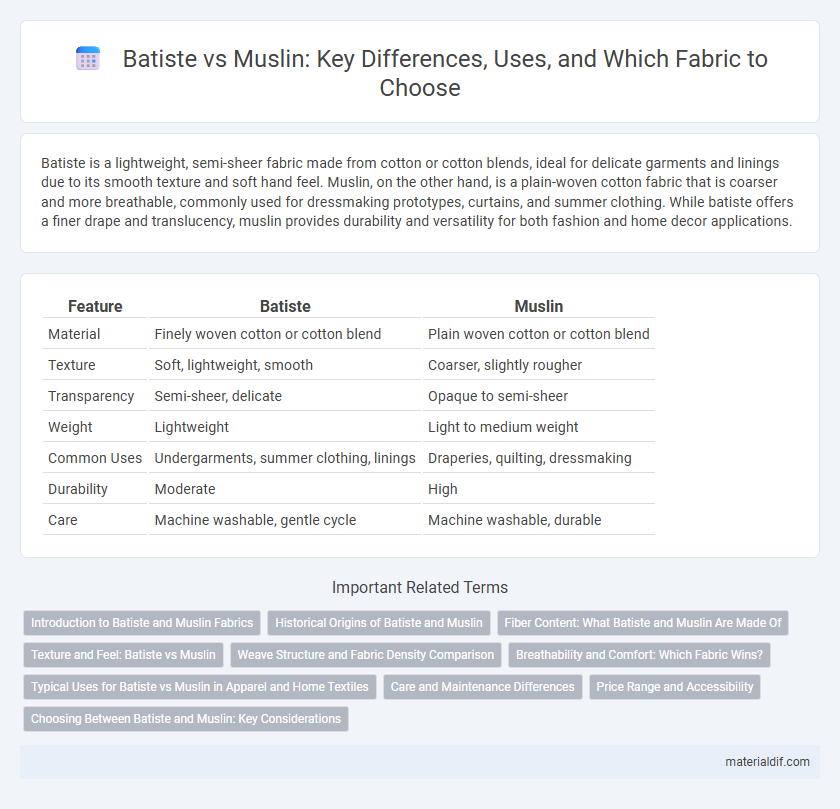Batiste is a lightweight, semi-sheer fabric made from cotton or cotton blends, ideal for delicate garments and linings due to its smooth texture and soft hand feel. Muslin, on the other hand, is a plain-woven cotton fabric that is coarser and more breathable, commonly used for dressmaking prototypes, curtains, and summer clothing. While batiste offers a finer drape and translucency, muslin provides durability and versatility for both fashion and home decor applications.
Table of Comparison
| Feature | Batiste | Muslin |
|---|---|---|
| Material | Finely woven cotton or cotton blend | Plain woven cotton or cotton blend |
| Texture | Soft, lightweight, smooth | Coarser, slightly rougher |
| Transparency | Semi-sheer, delicate | Opaque to semi-sheer |
| Weight | Lightweight | Light to medium weight |
| Common Uses | Undergarments, summer clothing, linings | Draperies, quilting, dressmaking |
| Durability | Moderate | High |
| Care | Machine washable, gentle cycle | Machine washable, durable |
Introduction to Batiste and Muslin Fabrics
Batiste fabric is a lightweight, fine, and semi-sheer cotton or cotton-blend fabric known for its smooth texture and delicate appearance, often used in elegant garments and handkerchiefs. Muslin, on the other hand, is a loosely woven cotton fabric characterized by its breathability and versatility, frequently utilized in dressmaking, upholstery, and as a base fabric for pattern making. Both fabrics offer distinct textures and weights that cater to different functional and aesthetic needs in textile applications.
Historical Origins of Batiste and Muslin
Batiste originated in the early 19th century, named after Jean-Baptiste, a French linen weaver, and was prized for its fine, soft texture derived from high-quality cotton or linen fibers. Muslin dates back to the ancient regions of Bengal, India, where its lightweight, loosely woven cotton fabric became internationally renowned during the Mughal era for its delicate yet durable qualities. Both fabrics have significantly influenced textile history, with batiste favored in European fashion circles and muslin serving as a foundational cloth in South Asian garment traditions.
Fiber Content: What Batiste and Muslin Are Made Of
Batiste fabric is typically made from fine combed cotton or a cotton-polyester blend, offering a soft, lightweight, and slightly sheer texture ideal for delicate garments. Muslin is woven primarily from 100% cotton fibers, producing a looser weave that provides breathability and versatility, often used in dressmaking, upholstery, and culinary applications. The natural cotton content in both fabrics ensures comfort, but batiste's finer yarns create a more polished appearance compared to the coarser, rustic feel of muslin.
Texture and Feel: Batiste vs Muslin
Batiste fabric offers a smooth, lightweight texture with a soft, almost silky feel that drapes elegantly, making it ideal for delicate garments and fine linens. Muslin, contrastingly, has a coarser, more open weave with a matte finish that gives it a slightly rougher, more breathable texture commonly used for casual wear and utilitarian purposes. Both fabrics provide breathability, but Batiste excels in softness while Muslin stands out for its durability and rustic charm.
Weave Structure and Fabric Density Comparison
Batiste features a fine, lightweight plain weave structure with a high thread count that creates a smooth, delicate texture ideal for summer garments and handkerchiefs. Muslin consists of a simple, loosely woven plain weave with lower fabric density, resulting in a more breathable and sheer material commonly used for dressmaking and mock-ups. The tighter weave and higher yarn density in Batiste offer better durability and softness compared to the coarser, more open weave of Muslin.
Breathability and Comfort: Which Fabric Wins?
Batiste fabric, made from fine cotton or cotton blends, is lightweight and extremely breathable, making it ideal for warm weather and comfortable wear. Muslin, typically made from loosely woven cotton, offers excellent breathability but tends to be thicker and less smooth against the skin compared to batiste. For optimal comfort and airflow, batiste generally outperforms muslin due to its finer weave and softer texture.
Typical Uses for Batiste vs Muslin in Apparel and Home Textiles
Batiste is a finely woven, lightweight fabric commonly used in delicate apparel such as summer dresses, blouses, and lingerie due to its soft texture and breathable quality. Muslin, characterized by its plain weave and coarser texture, serves well in home textiles like curtains, bed linens, and as a base fabric for upholstery because of its durability and versatility. Both fabrics are favored for their natural fiber content and airflow, but batiste excels in luxury clothing while muslin is preferred for functional household applications.
Care and Maintenance Differences
Batiste fabric requires gentle hand washing or delicate machine cycles with cold water to maintain its soft texture and prevent shrinkage. Muslin, being more durable, tolerates regular machine washing and higher temperatures, but should be air-dried to avoid excessive wear and maintain its breathable quality. Both fabrics benefit from minimal ironing on low heat to preserve their lightweight nature and prevent damage.
Price Range and Accessibility
Batiste fabric typically falls in the mid to high price range due to its fine cotton or cotton blend weave and delicate texture, making it moderately accessible in specialty fabric stores and online. Muslin, known for its affordability and availability, is priced lower and widely accessible in various grades, from coarse to fine, across general fabric retailers and wholesale suppliers. The price disparity between Batiste and Muslin reflects the quality and finish, with Muslin being a budget-friendly option suitable for various applications.
Choosing Between Batiste and Muslin: Key Considerations
Batiste and muslin differ significantly in texture, weight, and uses, making fabric choice dependent on project requirements. Batiste features a fine, smooth weave ideal for lightweight garments and delicate detailing, while muslin offers a coarser, open weave suited for dressmaking prototypes and breathable home textiles. Consider factors such as fabric weight, thread count, and intended application to select the most appropriate material for durability and aesthetic needs.
Batiste vs Muslin Infographic

 materialdif.com
materialdif.com